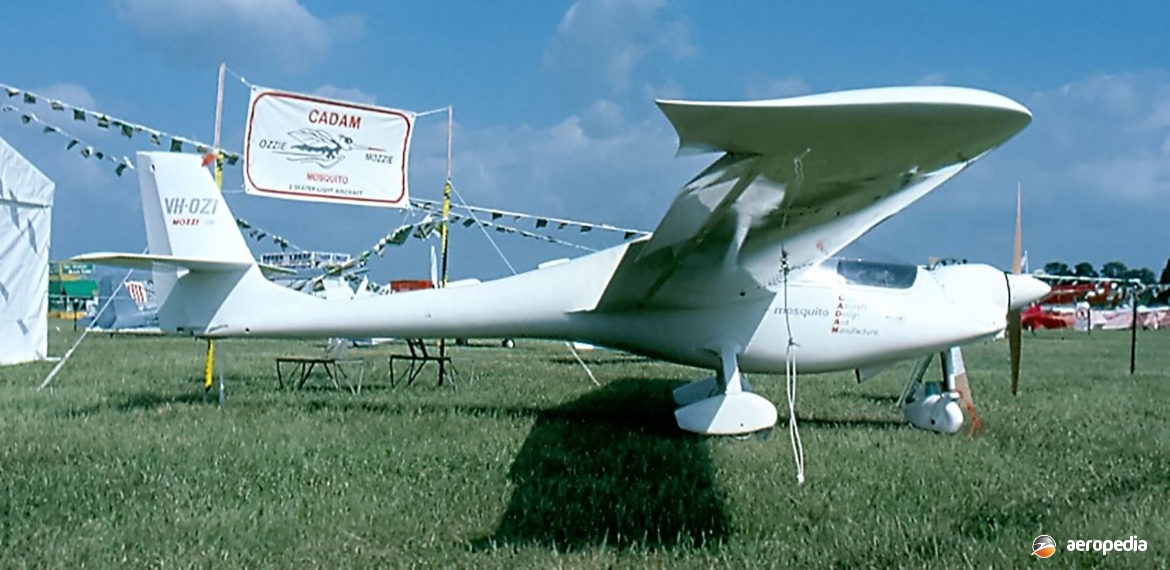Photograph:
Buchanan BAC-204 Mosquito VH-OZI (c/n 01) at the Australian Bicentennial Air Show at Richmond, NSW in 1988 (David C Eyre)
Country of origin:
Australia
Description:
Two-seat light utility aircraft
Power Plant:
One 60 kw (80 hp) Rotax 912-A1 four-stroke, four-cylinder, horizontally-opposed liquid-and-air-cooled engine
Specifications:
- Wingspan: 10.5 m (34 ft 5 in)
- Length: 6.4 m (20 ft 11 in)
- Height: 2.3 m (7 ft 6½ in)
- Wing area: 10.2 m² (109.79 sq ft)
- Max speed at sea level: 188 km/h (117 mph)
- Cruising speed at 70% power at 1,981 m (6,500 ft): 185 km/h (115 mph)
- Stalling speed flaps down: 81 km/h (51 mph)
- Rate of climb at sea level: 244 m/min (800 ft/min)
- Service ceiling: 5,486 m (18,000 ft)
- Range with 45 mins reserve at 70% power at 1,981 m (6,500 ft): 971 km (603 miles)
- Empty weight: 350 kg (772 lb)
- Loaded weight: 600 kg (1,323 lb)
History:
The Buchanan Mosquito made its public debut at the Australian Bicentennial Air Show at RAAF Richmond, NSW in October 1988, being a two-seat light aircraft built by the Buchanan Aircraft Corporation Ltd at Toowoomba, QLD. This Company specialised in composite design and manufacture and was CAA approved for civil aircraft design, engineering, stressing and modification. The Company commenced the Mosquito project in 1986, the aircraft being of composite materials with a mid-wing, which was swept forward and a tricycle undercarriage. It was aimed at being certificated as a light aircraft under ANO 101.22.
The prototype VH-OZI (c/n 01) was registered on 4 November 1988 as a Murray Mosquito BC-203 and was powered by a 48 kw (64 hp) Rotax 532 engine, being flown for the first time in 1988. It also became known as the Cadam Mosquito. Subsequently the design was refined to take the 67 kw (90 hp) Norton NR-642 rotary engine, or a conventional Emdair two-cylinder, four-stroke engine, this allowing the size of the cockpit to be increased. At the same time the tail was replaced with a “T” type and the tail boom lengthened, this allowing for higher engine weights and a greater payload capacity. The aircraft, VH-OZI, was withdrawn from service on 23 April 1990.
A further prototype was built VH-OZE (c/n P.2), being registered on 4 December 1991, flying for the first time on 11 December 1990, and commencing its flight test program thereafter, with plans to be certified to JAR VLA. This was built more like the definitive production aircraft and many aspects conformed to FAR Pt 23, including the laminar profile wing; low-drag waisted fuselage; high manoeuvrability and docile stall; and the expected adaptation for IMC flight.
It was aimed at the market for a training aircraft that could carry out surveillance, mustering, or military forward air control. Production engine was to be the 60 kw (80 hp) Rotax 912-A1 driving a two-blade fixed-pitch propeller, fuel capacity being 100 litres (22 Imp gals). Seating was for two side-by-side under a one-piece fully transparent canopy; and space for 30 kg (66 lb) of baggage was provided behind the seats. This aircraft, VH-OZE, was retired and withdrawn from use on 15 October 2000.
Development was said to be continuing, and it was proposed to produce a homebuilt version in kit form. However, by early 2020 no further examples are known to have been completed.

